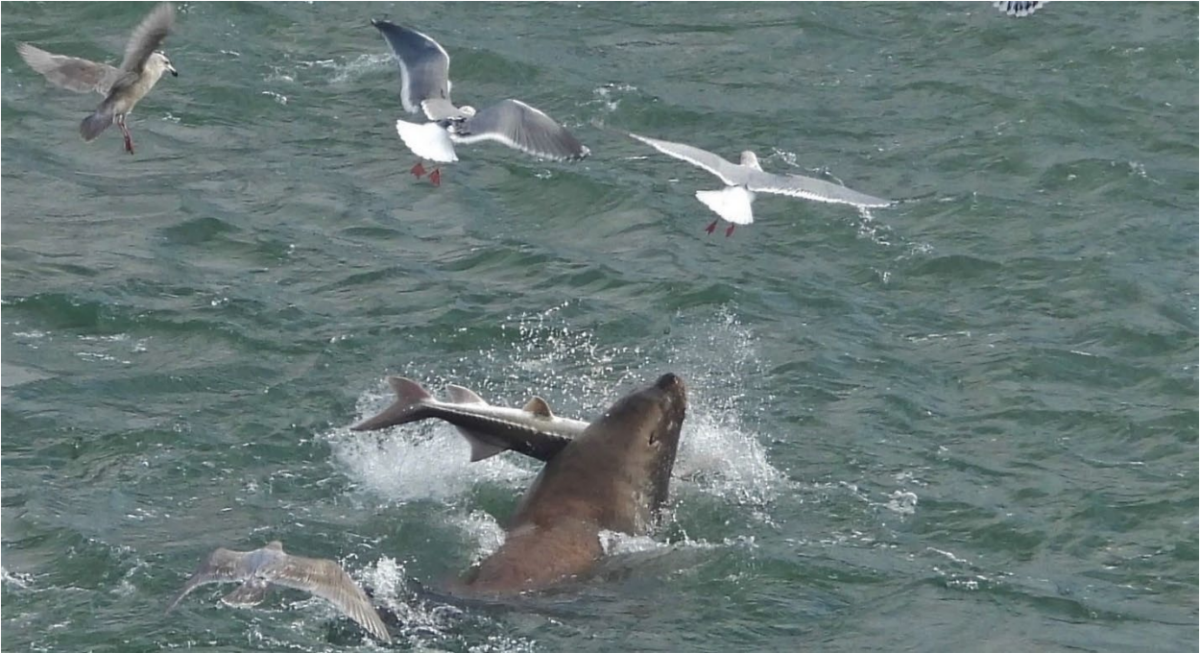
Bonneville Sea Lion Removal Operations Ongoing, Just 2 Culled
Columbia pinniped managers say they have lethally removed two sea lions so far this spring at Bonneville, a tally that will bring inevitable “rookie numbers” memes given all the pinnipeds in the big river this spring, but operations are expected to continue at the dam into late May.
The marine mammals have flooded in from the Pacific following a late return of eulachon smelt and spring Chinook, and many are sticking around to feed on sturgeon and outmigrating salmon and steelhead smolts.

Large gatherings of sea lions at places such as the mouth of the Cowlitz and a few 70 miles upstream at Barrier Dam attracted widespread attention and last weekend Waashington state Senator Jeff Wilson (R-Longview) said he’d called for a meeting with WDFW over the issue.
Details are still being worked out, but it could take place in the coming week or two, according to agency spokesman Ben Anderson.
He acknowledges sea lion numbers are on “the high side” this year, but adds that they’re “not dramatically higher than normal.”
That’s based on a count at Astoria’s East Mooring Basin docks, which is used as a proxy for overall abundance because no river-wide tally is performed.
“The highest count ODFW has for this year is 1,460 sea lions on March 7,” Anderson reported.
While state and tribal managers can’t lethally remove pinnipeds at that location, thanks to a 2018 Congressional amendment of the Marine Mammal Protection Act they do have that authority on the mainstem Columbia from the I-205 bridge upstream to McNary Dam, and in all tributaries home to ESA-listed salmon and steelhead spawning runs. The goal, as explained by ODFW, is to create “safe zones” for fish.
The issue, however, is that the capacity to perform removals is limited to haul-out traps, and those are only currently stationed at Bonneville and below Willamette Falls. After their chums crawl inside for forever naps, sea lions learn to avoid them.
“The main obstacle to removing the remaining sea lions at Willamette Falls is their lack of use of the traps,” says ODFW’s annual management report for 2022.
But it hasn’t been all for naught at the falls. Control efforts there resulted in “substantial and sustained decreases in predator abundance and associated predation compared to pre-management years, particularly for listed winter steelhead,” the agency stated.
“Changes to capture protocols (e.g., relocating traps, darting animals in the water) will likely have to be made to completely eliminate this remaining source of salmonid mortality,” ODFW also suggested.
So why can’t sea lions just be shot with rifles and save a lot of taxpayer money and time, not to mention Endangered Species Act-listed Chinook, steelhead, smelt and coho, and weak stocks like Columbia sturgeon?
Under the 2019 permit issued by NMFS to state and tribal fish and wildlife managers in support of Congress’s amendment, the use of firearms by what is known as the “Eligible Entities” to kill the animals is “expressly prohibited.”
On the flip side, removals are no longer contingent on nonlethal hazing measures being first attempted, a la Herschel et al at the Ballard Locks, nor do managers have to identify specific animals in the act of eating fish in order to remove them.
To that end, two years ago ODFW and WDFW launched a website where the public can report their sea lion and harbor seal sightings. At that time it was stated that the “crowdsourced data” was meant “to be used to investigate potential pinniped ‘hot spots’ for future research or management activities.”

Officials have stated they need more money to build facilities large enough to handle the much larger Stellers.
Washington’s just-passed 2023-25 operating budget does provide $1.5 million “for expanded management of pinniped populations on the lower Columbia river and its tributaries with the goal of increasing chinook salmon abundance and prey availability for southern resident orcas.”
WDFW had hoped that funding would be “ongoing,” that is, written into the 2025-27 budget, but lawmakers designated it “one-time,” meaning the agency will have to request it again in two years.
Show us that this isn’t just a money suck and let’s get to work.
The federal removal permit is good from mid-August 2020 to mid-August 2025 and under it, a maximum of 540 California sea lions and 176 Stellers can be killed, figures that are well within the so-called “potential biological removal” limit for each species. CSLs are considered “fully rebounded” and at carrying-capacity, and the eastern Pacific stock of SSLs has been federally delisted.
Counting this spring’s two removals at Bonneville, 40 CSLs as well as 53 SSLs have been euthanized under the permit.

